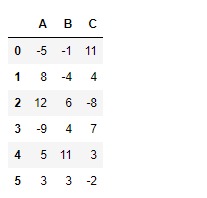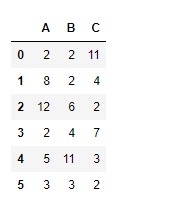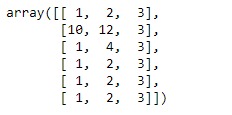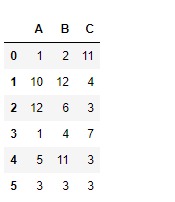Python是進行數據分析的一種出色語言,主要是因為以數據為中心的python軟件包具有奇妙的生態係統。 Pandas是其中的一種,使導入和分析數據更加容易。
Pandas dataframe.clip_lower()用於在指定的輸入閾值處修整值。我們使用此函數將所有值修整到輸入值的閾值以下。
用法: DataFrame.clip_lower(threshold, axis=None, inplace=False)
參數:
threshold:數字或array-like
float :將每個值與閾值進行比較。
array-like:閾值的形狀應與被比較的對象匹配。當self為Series時,閾值應為長度。當self是DataFrame時,閾值應為2-D,並且對於axis = None,其形狀應與self相同,或者為1-D,且長度與要比較的軸相同。
axis:沿給定軸將自身與閾值對齊。
inplace:是否對數據執行適當的操作。
返回:剪切:與輸入類型相同
範例1:采用clip_lower()用於將數據幀的值修整到給定閾值以下的函數。
# importing pandas as pd
import pandas as pd
# Creating a dataframe using dictionary
df = pd.DataFrame({"A":[-5, 8, 12, -9, 5, 3],
"B":[-1, -4, 6, 4, 11, 3],
"C":[11, 4, -8, 7, 3, -2]})
# Printing the data frame for visualization
df
現在將所有低於2的值修剪為2。
# Clip all values below 2
df.clip_lower(2)輸出:

範例2:采用clip_lower()用於將 DataFrame 中的值裁剪為該 DataFrame 中每個單元格具有特定值的函數。
為此,我們可以使用numpy數組,但是數組的形狀必須與 DataFrame 的形狀相同。
# importing pandas as pd
import pandas as pd
# Creating a dataframe using dictionary
df = pd.DataFrame({"A":[-5, 8, 12, -9, 5, 3],
"B":[-1, -4, 6, 4, 11, 3],
"C":[11, 4, -8, 7, 3, -2]})
# lower limit for each individual column element.
limit = np.array([[1, 2, 3], [10, 12, 3], [1, 4, 3],
[1, 2, 3], [1, 2, 3], [1, 2, 3]])
# Print lower_limit
limit
現在將這些限製應用於 DataFrame
# applying different limit value
# for each cell in the dataframe
df.clip_lower(limit)輸出:

每個單元格值均已根據所應用的相應下限進行了修剪。
相關用法
- Python pandas.map()用法及代碼示例
- Python Pandas Series.str.len()用法及代碼示例
- Python Pandas.factorize()用法及代碼示例
- Python Pandas TimedeltaIndex.name用法及代碼示例
- Python Pandas dataframe.ne()用法及代碼示例
- Python Pandas Series.between()用法及代碼示例
- Python Pandas DataFrame.where()用法及代碼示例
- Python Pandas Series.add()用法及代碼示例
- Python Pandas.pivot_table()用法及代碼示例
- Python Pandas Series.mod()用法及代碼示例
- Python Pandas Dataframe.at[ ]用法及代碼示例
- Python Pandas Dataframe.iat[ ]用法及代碼示例
- Python Pandas.pivot()用法及代碼示例
- Python Pandas dataframe.mul()用法及代碼示例
- Python Pandas.melt()用法及代碼示例
注:本文由純淨天空篩選整理自Shubham__Ranjan大神的英文原創作品 Python | Pandas dataframe.clip_lower()。非經特殊聲明,原始代碼版權歸原作者所有,本譯文未經允許或授權,請勿轉載或複製。
